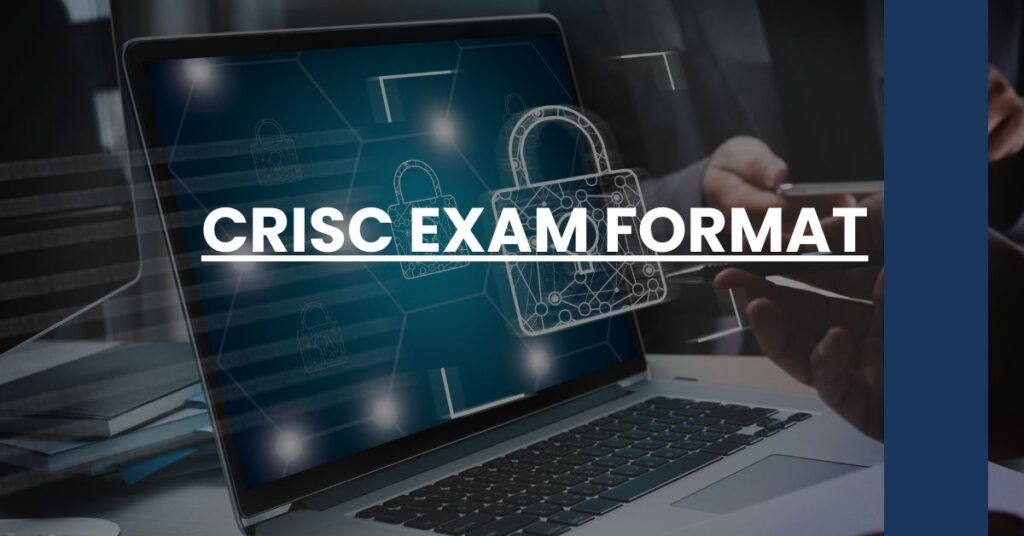The CRISC exam format consists of 150 multiple-choice questions covering key areas in IT risk management and control. This structured test assesses candidates’ expertise in risk identification, assessment, response, mitigation, and monitoring.
In this article, you’ll gain insights on:
- The specific domains of study for the exam
- Eligibility criteria and the experience required to take the test
- Effective strategies for exam preparation
Equipped with this knowledge, you’ll be ready to tackle the CRISC exam confidently, propelling your career in IT risk management forward.
- Understanding the CRISC Certification
- Detailed Breakdown of the CRISC Exam Format
- Key Components of the CRISC Exam
- Exam Requirements for CRISC Certification
- Preparation Tips for the CRISC Exam
- CRISC Exam Scheduling and Logistics
- After the CRISC Exam: Next Steps
- Maintaining CRISC Certification
- Conclusion: Launching Your Risk Management Career with CRISC
Understanding the CRISC Certification
Certified in Risk and Information Systems Control (CRISC) is a certification that can play a pivotal role in your career trajectory if you’re determined to demonstrate expertise in identifying and managing IT risk, and implementing and maintaining information systems controls. The CRISC certification, offered by ISACA, is recognized internationally, adding substantial credibility to your professional profile. This credential is tailored for IT professionals, project managers, and others whose role encompasses risk management and information system control.
To comprehend why this certification is so valued, it’s important to understand the landscape of IT risk. In our fast-paced digital world, organizations increasingly depend on robust information systems, but with this dependence comes the inevitable risk. As a CRISC-certified professional, you possess the knowledge and skills to anticipate and mitigate these risks, making you an asset to any enterprise.
Detailed Breakdown of the CRISC Exam Format
When preparing for the CRISC exam, familiarizing yourself with the exam structure is crucial. The CRISC exam format is quite straightforward but demands comprehensive preparation. Here’s the nitty-gritty of what to expect:
- Number of Questions: You’ll be tasked with answering 150 multiple-choice questions.
- Exam Duration: You are given 4 hours to complete the exam.
- Passing Score: A scaled score of 450 or higher is required to pass.
Each question on the exam intends to assess your aptitude across various job practice areas aligned with the most current industry standards.
Key Components of the CRISC Exam
To accurately reflect the reality of IT risk management, the CRISC exam is divided into four domains. Understanding what’s covered within these domains ensures you’re prepared for what’s to come:
- Risk Identification: This domain helps ensure that you can identify and evaluate risk to provide a solid foundation for the further assessment and treatment.
- Risk Assessment: Next, you’ll delve into analyzing and evaluating risk based on data, so you know where to prioritize your efforts.
- Risk Response and Mitigation: Here, you will learn to develop and implement risk responses to mitigate identified risks effectively.
- Risk and Control Monitoring and Reporting: Finally, you’ll need to demonstrate skills in monitoring risk and controls and reporting on them over time.
Each domain contributes a percentage to the test weighting, reflecting its relative importance and the amount of content covered in the exam. For example, the risk assessment domain constitutes a significant portion, emphasizing the importance of not just identifying risks, but also evaluating their magnitude and potential impact.
While the CRISC exam content outline offers detailed information, a strong understanding of these domains is imperative to demonstrate your capability to not just tackle the CRISC exam, but also real-world challenges in IT risk management.
Exam Requirements for CRISC Certification
In order to sit for the CRISC exam, there are certain prerequisites you must meet, serving as evidence that you possess the foundational skills necessary to benefit from the certification. These requirements are in place to ensure that only those with relevant experience advance to become CRISC-certified professionals.
First and foremost, you’re expected to adhere to the ISACA Code of Professional Ethics, which underscores the professional and ethical conduct in the practice of risk and information systems control.
Secondly, you need to have:
- Work Experience: A minimum of three years of cumulative work experience performing the tasks of a CRISC professional across at least two of the four CRISC domains, one of which must be in Domain 1 or 2. This experience must be gained within the five years preceding the application, or within ten years if you pass the exam and then complete the required work experience.
Education and other professional certifications can’t replace the required work experience. It is this hands-on, practical experience that gives CRISC its real-world value.
By meeting these prerequisites, you demonstrate your readiness, both on paper and in practice, to take the CRISC exam and step into the world of IT risk management with confidence.
Preparation Tips for the CRISC Exam
As you edge closer to the date of your CRISC exam, preparation becomes paramount. Here are some tips to ensure you are fully equipped to tackle the crisc exam format with confidence:
1. Familiarize with the Content: Start by thoroughly understanding the CRISC exam syllabus. Break down the domains and focus on each segment, ensuring a deep comprehension of the topics.
2. Structured Study Plan: Devote time daily or weekly to study, depending on your schedule. Organizing your study into manageable blocks will help maintain focus and reduce stress.
3. Official Study Materials: Utilize ISACA’s resources such as the CRISC Review Manual and CRISC Review Questions, Answers & Explanations Manual. These materials are tailored to give you a clear picture of the crisc exam format and the types of questions to expect.
4. Training Courses: Consider enrolling in formal training courses that provide structured learning and insights from experienced instructors.
5. Practice Tests: Take as many practice tests as you can. This will not only test your knowledge but also get you accustomed to the exam timing and pressure.
6. Join Study Groups: Engaging with peers in study groups can expose you to different study methods, critical insights, and moral support.
7. Review and Reflect: Regularly review what you have learned and reflect on areas that need improvement. Don’t just memorize; seek to truly understand the rationale behind the concepts.
Remember, discipline and determination are critical. Adhering to a study routine that covers all the necessary material and mimics the real exam scenario can make a significant difference in your CRISC exam outcome.
CRISC Exam Scheduling and Logistics
With your preparation in full swing, now is also the time to nail down the logistical aspects of your CRISC exam. Here’s what you need to know about scheduling and logistics:
1. Registration: You can register for the CRISC exam through the ISACA website. Ensure your membership profile is up to date to streamline the registration process.
2. Choosing a Date: Select an exam date that allows sufficient time to prepare – avoid rushing your preparation.
3. Testing Centers: ISACA offers testing centers worldwide. Choose a convenient location to minimize travel-related stress on the day of the exam.
4. What to Bring: On the exam day, you’ll need two forms of identification, and be sure to familiarize yourself with the testing center’s policies, including what items are prohibited.
5. On Exam Day: Arrive early to allow yourself ample time to check-in, relax, and mentally prepare.
By having the logistics sorted well in advance, you can concentrate solely on the exam without any last-minute hurdles throwing you off balance.
After the CRISC Exam: Next Steps
Once you’ve completed your CRISC exam, you might be curious about what happens next. The wait for results can be nerve-wracking, but here’s what to expect:
1. Exam Results: Typically, exam results are emailed to candidates within 10 working days of the exam date.
2. Understanding Your Score: A scaled score is used; a score of 450 or higher means you’ve passed. If you don’t pass, detailed feedback will help you target areas for improvement.
3. Retaking the Exam: If necessary, you can register to retake the CRISC exam, taking into account the feedback and doubling down on your preparation in weaker areas.
Once you pass, you’re on your way to becoming a certified CRISC professional – subject to meeting the work experience requirements. This milestone is more than a designation; it’s a stepping stone toward leadership roles in IT risk and control.
Maintaining CRISC Certification
After the pomp of passing your exam fades, it’s essential not to neglect the ongoing requirements to maintain your CRISC qualification. This long-term commitment to professional development ensures that your skills remain sharp and your knowledge current in an ever-evolving field.
To maintain your certification, you’ll need to:
- Submit CPE Hours: Accumulate and report a minimum of 20 Continuing Professional Education (CPE) hours annually and 120 CPE hours every three years.
- Abide by the Code of Ethics: Uphold the ISACA Code of Ethics to ensure integrity and professionalism in your practice.
- Pay Maintenance Fees: An annual maintenance fee is required to sustain your certification status.
By continuing to invest in your professional growth and adhering to ISACA’s standards, you secure your place as a trusted expert in the field of risk and information systems control.
Conclusion: Launching Your Risk Management Career with CRISC
The CRISC certification is not just a testament to your expertise in IT risk management; it’s a beacon that guides you toward promising career opportunities. A detailed understanding of the crisc exam format and thorough preparation can set you apart as a distinguished professional capable of safeguarding and strengthening information systems within any organization.
With every step you take—from grasping the exam content, planning your studies, acing the exam, to maintaining your certification—you’re building the foundations for a robust career that could define the future of risk management within the digital landscape.
Embrace the journey, for it paves the way to a fulfilling and sought-after role in the burgeoning domain of IT risk management and control.

